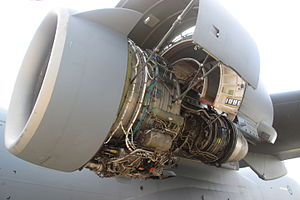Pratt & Whitney PW2000
| PW2000/F117 | |
|---|---|
 |
|
| F117 engine with cowlings opened | |
| Type | Turbofan |
| Manufacturer | Pratt & Whitney |
| First run | December 1981 |
| Major applications |
Boeing 757 Boeing C-17 Globemaster III Ilyushin Il-96M |
The Pratt & Whitney PW2000, also known by the military designation F117 and initially referred to as the JT10D, is a series of high-bypass turbofan aero engines with a thrust range from 37,000 to 43,000 lbf (165 to 190 kN). Built by Pratt & Whitney, they were designed for the Boeing 757. As a 757 powerplant, these engines compete with the Rolls-Royce RB211.
Pratt & Whitney began working on the JT10D in October 1971 intended for the McDonnell Douglas YC-15 into the Advanced Medium STOL Transport project and the Boeing 767 then code named 7X7, which first ran in August 1974. In December 1980, Pratt & Whitney changed to a new naming system for its engines and the JT10D became the PW2037.
The PW2000 is a dual-spool, axial air flow, annular combustion, high by-pass turbofan with a dual-channel Full authority digital engine control (FADEC) system. It was certified in 1984 as the first civilian FADEC-controlled aviation engine.
MTU Aero Engines holds a 21.2% stake in the engine, having developed the low-pressure turbine and turbine exit casing as well as producing critical parts of the low-pressure turbine, the turbine exhaust casing, high-pressure compressor and high-pressure turbine components.
The first PW2000 series engine, the PW2037, powered the Boeing 757-200 and entered service with Delta Air Lines as the launch customer for the civil aviation version of the engine.
Other than the 757, the PW2000 series engines also power the C-17 Globemaster III military transport; the United States Department of Defense designation for the engine is F117, with the specific variant used on the C-17 being the F117-PW-100. The powerplant first flew on the C-17 in 1991.
...
Wikipedia
